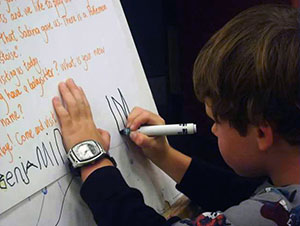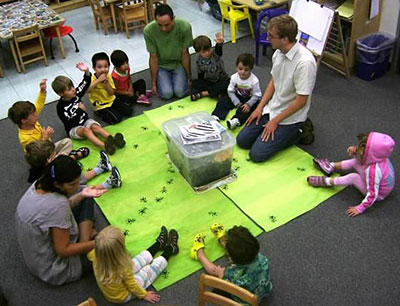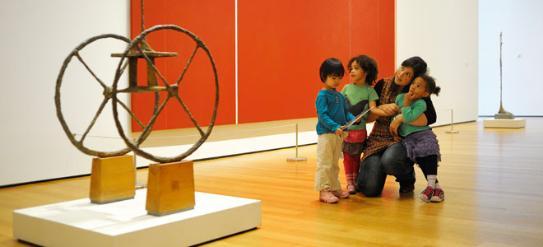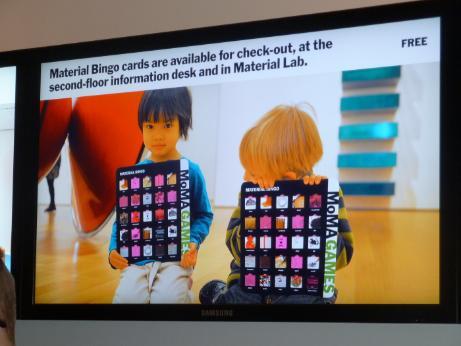Preschool Classroom
3 to 5 Years

CLASSROOM ENVIRONMENT
The materials and activities of the preschool classroom evolve throughout the year to meet the emerging learning interests of its children. Throughout the space, there are designated areas for a variety of activities. There is a block area with both hollow and unit blocks, dramatic play area with a loft, a reading area with books and pillows, an art materials corner, small manipulatives, games, puzzles, toys, and a central rug for classroom meetings. New materials are introduced and rotated throughout the year in response to the children's emerging interests and learning needs. The room contains a bathroom, a row of tables for lunch and snacks, as well as a kitchen for cooking projects.
Children's art and photos of children, teachers, and families are central to the preschool classroom and can be found displayed on the walls and shelves. Art and construction play have an important role in transforming the classroom to reflect emerging themes in the children's play. For example, the class may meet to discuss an interest in outer space and spend several weeks studying images and concepts of space and space travel. Features may be added to the loft to create a spaceship and the walls and ceilings covered in diverse representations of the galaxy. The loft has also been tranformed into a car, castle, house, igloo, and jungle.

TEACHERS AS CAREGIVERS
The preschool classroom has two head teachers who serve as mentors to a number of graduate students from the Teachers College community who are working in the classroom on a semester or year-long basis. Given the number of adults in the classroom, teachers are usually able to provide individual attention on a regular basis to address the children's unique needs. In addition, the teachers and graduate students work together to create a dynamic environment that is conducive to both large- and small-group learning activities.
Teachers take on a variety of roles throughout the course of the day. Teachers may prepare small group activities such as baking, painting, playwriting, and gardening. Children may choose to join these activities or continue their play. Teachers may participate in dramatic play with the children. They are invited by the children to be full partners in constructing the play. Teachers also observe and record children's activities and interests to share with parents and inform curriculum.

CURRICULUM
The preschool room at the Rita Gold Early Childhood Center is a mixed age, inclusive community that serves children between the ages of 3 and 5 years old. We provide care that serves a wide range of abilities and needs. In line with the Center philosophy we place the child at the center of the curriculum and develop themes and project-based work in response to their interests and needs. The teachers and graduate students devote time to observing and listening to the children within the context of a play-based learning environment. From these observations, learning opportunities are constructed to meet a range of developmental needs and skills while also striving to challenge each child. The curriculum is structured to address all areas of development in an integrated model as we believe that a holistic approach is most effective when teaching and learning within an early childhood setting. In addition to music and art, the preschool children are also able, for a small fee, to take ballet and soccer. Field trips and special events are planned regularly based on children's evolving interests.
RATIO OF ADULTS TO CHILDREN
There is minimally a 1:5 ratio of adults to children in the preschool room with up to 15 children. Frequently we have additional graduate students in the classroom doing their field placements. This provides a low ratio which allows for careful documentation of the children's work and play and frequent communication and collaboration between teachers and families. In an effort to create a sense of community and allow the child's learning to extend beyond the classroom, the preschool teachers work to involve families and members from TC and the outside community in the curriculum whenever possible.
DAILY SCHEDULE
A typical day in the preschool classroom:
- 8:45-11:00 Free Play/Project Work
- 11:00-11:30 Clean-up, Meeting, Transition
- 11:30-12:30 Outdoor Gross Motor Play
- 12:30-1:30 Lunch & Transition to Nap (Children with a half-time schedule leave after lunch at 1 pm)
- 1:30-3:30 Nap
- 3:30-5:00 Free Play/Project Work
CURRICULAR ACTIVITIES & TIPS
In addition to the daily curricular activities, the preschool room is involved in year-long art and music programs within the TC community. Outside of the TC community, preschoolers participate in extracurricular activities such as ballet and soccer. To further explore classroom interests, preschoolers take field trips to museums, city landmarks, sports events and other places based on children's interests.
Preschoolers were invited to MoMA to explore museum materials

Preschoolers investigate MoMA galleries
